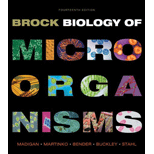
Brock Biology of Microorganisms Plus MasteringMicrobiology with eText -- Access Card Package (14th Edition)
14th Edition
ISBN: 9780321897077
Author: MADIGAN
Publisher: PEARSON
expand_more
expand_more
format_list_bulleted
Concept explainers
Question
Chapter 3, Problem 10RQ
Summary Introduction
Energy is released from the
Expert Solution & Answer
Want to see the full answer?
Check out a sample textbook solution
Students have asked these similar questions
Why is acetyl phosphate considered an energy-richcompound while glucose 6-phosphate is not?
How many molecules of Glucose-1 - phosphate can be generated from this molecule?
Why can only unsaturated triacylglyceroids undergo hydrogenation?
Chapter 3 Solutions
Brock Biology of Microorganisms Plus MasteringMicrobiology with eText -- Access Card Package (14th Edition)
Ch. 3.1 - Which four chemical elements make up the bulk of a...Ch. 3.1 - Which two classes of macromolecules contain most...Ch. 3.1 - Prob. 3MQCh. 3.2 - Why would a complex culture medium for Leuconostoc...Ch. 3.2 - In which medium shown in Table 5.1, defined or...Ch. 3.2 - What is meant by the word sterile? Why is aseptic...Ch. 3.3 - Prob. 1MQCh. 3.3 - Prob. 2MQCh. 3.4 - What is free energy?Ch. 3.4 - Prob. 2MQ
Ch. 3.4 - Using Table 3.2, calculate G0 for the reaction...Ch. 3.5 - Prob. 1MQCh. 3.5 - Prob. 2MQCh. 3.5 - Prob. 3MQCh. 3.6 - Prob. 1MQCh. 3.6 - Prob. 2MQCh. 3.6 - Prob. 3MQCh. 3.7 - How much free energy is released when ATP is...Ch. 3.7 - Prob. 2MQCh. 3.7 - Prob. 3MQCh. 3.8 - Which reactions in glycolysis are redox steps?Ch. 3.8 - Prob. 2MQCh. 3.8 - Prob. 3MQCh. 3.9 - Prob. 1MQCh. 3.9 - Prob. 2MQCh. 3.10 - Prob. 1MQCh. 3.10 - Which electron carriers described in this section...Ch. 3.11 - How do electron transport reactions generate the...Ch. 3.11 - Prob. 2MQCh. 3.11 - What structure in the cell links the proton motive...Ch. 3.12 - Prob. 1MQCh. 3.12 - What two major roles do the citric acid cycle and...Ch. 3.12 - Why is the glyoxylate cycle necessary for growth...Ch. 3.13 - Prob. 1MQCh. 3.13 - Prob. 2MQCh. 3.13 - Prob. 3MQCh. 3.14 - What form of activated glucose is used in the...Ch. 3.14 - Prob. 2MQCh. 3.14 - What functions does the pentose phosphate pathway...Ch. 3.15 - Prob. 1MQCh. 3.15 - List the steps required for the cell to...Ch. 3.15 - Which nitrogen bases are purines and which are...Ch. 3.16 - Prob. 1MQCh. 3.16 - Prob. 2MQCh. 3.17 - Prob. 1MQCh. 3.17 - Prob. 2MQCh. 3.17 - Prob. 3MQCh. 3 - Prob. 1RQCh. 3 - Prob. 2RQCh. 3 - What is aseptic technique and why is it necessary?...Ch. 3 - Prob. 4RQCh. 3 - REVIEW QUESTIONS
5. Describe how you would...Ch. 3 - Prob. 6RQCh. 3 - Why are enzymes needed by the cell? (Section 3.5)
Ch. 3 - Prob. 8RQCh. 3 - 9. What is the reduction potential of the...Ch. 3 - Prob. 10RQCh. 3 - How is ATP made in fermentation and in...Ch. 3 - Prob. 12RQCh. 3 - MINIQUIZ
13. Besides lactic acid and ethanol, list...Ch. 3 - List some of the key electron carriers found in...Ch. 3 - What is meant by proton motive force and how is it...Ch. 3 - Prob. 16RQCh. 3 - MINIQUIZ
17. How much more ATP is possible in...Ch. 3 - Prob. 18RQCh. 3 - MINIQUIZ
19. What is the major difference between...Ch. 3 - Prob. 20RQCh. 3 - Describe the process by which a fatty acid such as...Ch. 3 - Prob. 22RQCh. 3 - Prob. 1AQCh. 3 - Application Questions
2. Desulfovibrio can grow...Ch. 3 - Using the data of Figure 3.10, predict the...Ch. 3 - Prob. 4AQ
Knowledge Booster
Learn more about
Need a deep-dive on the concept behind this application? Look no further. Learn more about this topic, biology and related others by exploring similar questions and additional content below.Similar questions
- Why is B-D-Glucopyranose in a chair conformation form is the most stable form of glucose present in our body?arrow_forwardHow many different hydrolases are required to convert this polysaccharide to monosaccharides?arrow_forwardWhy can the more complex sugar cellulose store more energy than the sugar glucose?arrow_forward
- What is the difference between beta oxidation of fatty acid and beta oxidation of unsaturated fatty acid?arrow_forwardWhat are the typical fatty acid chains found in phosphoglycerides, and why do their carbon atom counts vary by multiples of two?arrow_forwardWhat sugar is produced by the epimerization of galactose?arrow_forward
- Why can aldoses and ketoses both behave as reducing sugars?arrow_forwardWhich of an alpha-D-2,3-di-O-methylglucopyranose or alpha-D-2,3, 6-tri-O-methylglucopyranose represents a glucose unit in glycogen which was originally carrying an (alpha 1-->6) glycosidic bond?arrow_forwardWhy is the sequence of reactions that catabolize fatty acids described as a spiral rather than a cycle?arrow_forward
arrow_back_ios
SEE MORE QUESTIONS
arrow_forward_ios
Recommended textbooks for you
 Human Heredity: Principles and Issues (MindTap Co...BiologyISBN:9781305251052Author:Michael CummingsPublisher:Cengage Learning
Human Heredity: Principles and Issues (MindTap Co...BiologyISBN:9781305251052Author:Michael CummingsPublisher:Cengage Learning

Human Heredity: Principles and Issues (MindTap Co...
Biology
ISBN:9781305251052
Author:Michael Cummings
Publisher:Cengage Learning